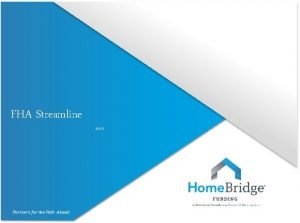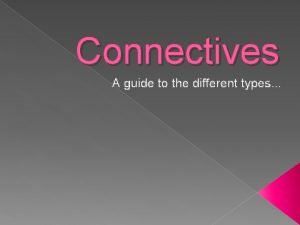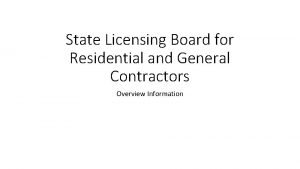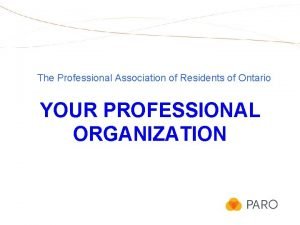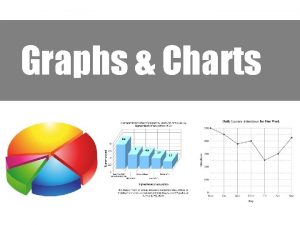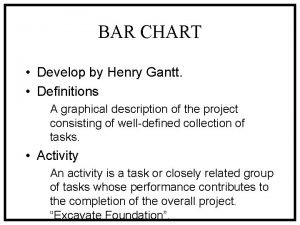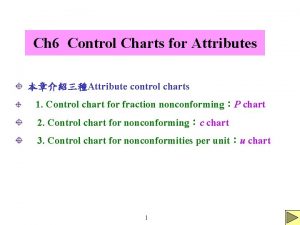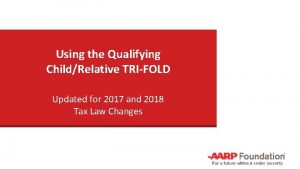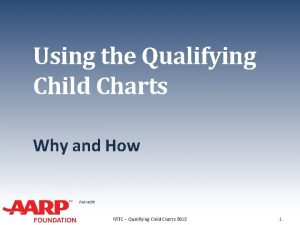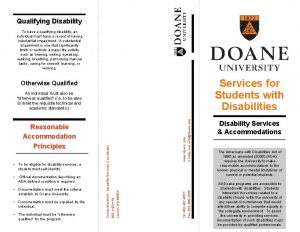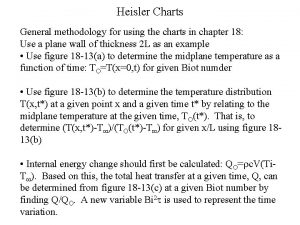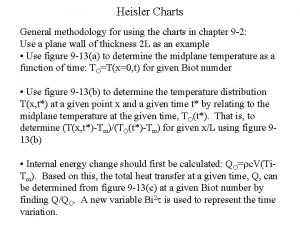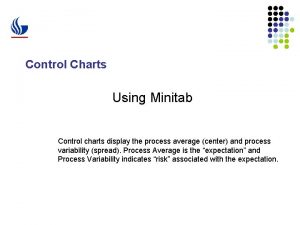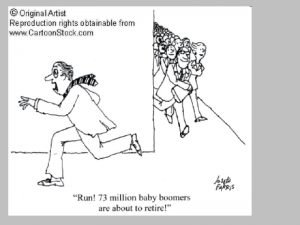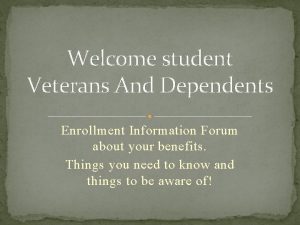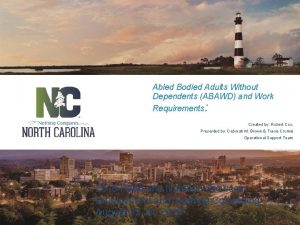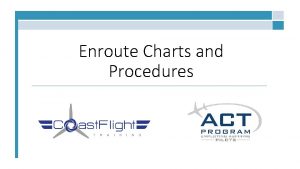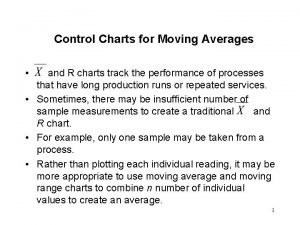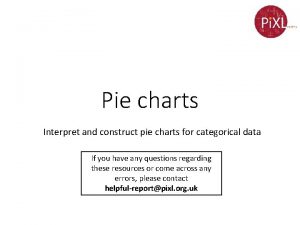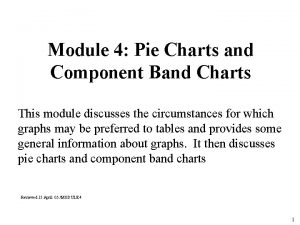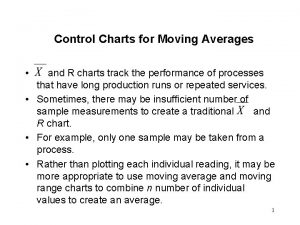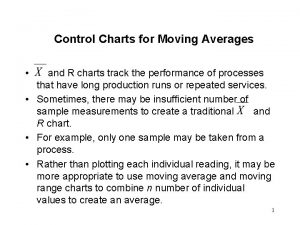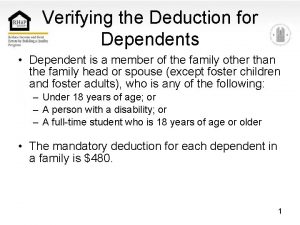Qualifying Dependents and Using the Qualifying ChildRelative Charts

































































- Slides: 65

Qualifying Dependents and Using the Qualifying Child/Relative Charts Trifold

Laminated Tri-Fold 2 NTTC Training – TY 2018 Every Tax-Aide Counselor should have the 2019 laminated tool (or 2018 with updates)

Intake/Interview Form (13614) 3 Verify and use the information under Part II

How to use them: Read the Introductory Page 4

Terms You Need to Know (back of laminated trifold) Custodial and noncustodial parent Relationships not terminated by divorce or death Eligible foster child Resident alien Full-time student School defined Gross income Any other taxpayer Incapable of self-care Temporary absence Permanently and totally disabled Tie-breaker Rules U. S. national 5

ALWAYS Start with Qualifying Child Chart 1 Use one taxpayer (or a taxpayer couple if filing MFJ) – referred to as “you” And one child or other person – referred to as “him” or “her” Use the child’s name when asking the questions 6

Follow the Arrows 7 If the answer to the question in Box 1 is “yes, ” follow the yes arrow to Box 3

Follow the Arrows 8 If the answer to the question in Box 3 is “yes, ” follow the Yes arrow to Box 5 And ask the question in Box 5

Blue Boxes When you get to a blue box, STOP The blue box lists ALL the benefits for which this child qualifies the taxpayer Read the whole box — important information is included in parentheses after most benefits Read any footnotes that apply — they are critical 9

Repeat for Other “Children” If there is an additional child (or household or family member) whose situation is different You may get to a different blue box 10

Start with the Middle Generation If the household has multiple generations, don’t start with the grandchildren, start with the children You’ll need to determine if they ARE dependents before you can determine if they HAVE dependents 11

ALWAYS Start with Qualifying Child Chart Even if you are analyzing a person who is not a qualifying child, start with the Qualifying Child Chart (Chart 1) You will be directed to the Qualifying Relative Chart (Chart 2) if appropriate Ø It is easy to mistake the child of a non-custodial parent as a qualifying relative 12

It looks very complicated, but. . . If your child’s situation is straightforward, the chart will take you straight down the left-hand side to Box 29 These are the same 10 questions you would answer from Page C-3 of the Resource Guide (Pub 4012) 13

1. 2. 3. 4. 5. 6. Citizenship? Relationship? Age? Younger than you? Residency? Child of more than one taxpayer (Check definition of taxpayer) 7. Child filing MFJ? 8. Can you be claimed as a dependent? 9. Parent separated and filing separate returns? 10. Did the child provide more than ½ of his own support? Then, person is qualifying child for all possible benefits 14

15

16

Example 1: John Child (John, age 12) is self-supporting because he receives social security survivor benefits which is used for his support Can he be claimed by his widowed mother with whom he lives? 17

Ex. 1: Start with John as QC of His Mother Box 1, ask: Was John a US citizen, national or a resident alien or a resident of Mexico or Canada for some part of the tax year? Yes – go to box 3 18

Ex. 1: John as QC of His Mother Box 3, ask: Was John your son, daughter, stepchild, eligible foster child, brother, sister, half-brother, half -sister, stepbrother, stepsister, or a descendant of any of them? Yes, go to box 5 19

Ex. 1: John as QC of His Mother Box 5, ask: Was John under age 19 at the end of the year? Yes, go to box 7 Box 7, ask: Was John younger than you? (“you” = Mother) Yes, go to box 10 20

Ex. 1: John as QC of His Mother Box 10 ask: Except for temporary absences, did John live with you for more than half the year? (See exceptions for birth, death or kidnapping. ) Yes, go to box 12 21

Ex. 1: John as QC of His Mother Box 12, ask: Is John the qualifying child for any other taxpayer? [i. e. Except for temporary absences, did John live with any other close relative (for example, parent, grandparent etc. , aunt, uncle, older sibling) more than ½ the year? ] No, go to box 21 22

Ex. 1: John as QC of His Mother Box 21, ask: Is John filing a MFJ tax return? [Answer “no” if filing only to get a refund of withholding or estimated tax paid. ] No, go to box 22 Box 22, ask: Can you the TP (or your spouse if filing MFJ) be claimed as a dependent on any other taxpayer’s return? No, go to box 23 23

Ex. 1: John as QC of His Mother Box 23, ask: Are John’s parents divorced, legally separated or lived apart all last ½ of the year? (John’s dad is deceased) No, go to box 28 24

Ex. 1: John as QC of His Mother Box 28, ask: Did John provide more than ½ his own support? Yes, go to box 30 25

Ex. 1: John as QC of His Mother Box 30: STOP – Blue box! John is your qualifying child for earned income credit IF 1. He is not married, 2. Both you and he have valid SSNs, and 3. You are not the qualifying child of another taxpayer But note: • No head of household • No dependency exemption • No child tax credit, etc. 26

Ex. 1: Enter John in the Dependents Section 27 Not a dependent, but yes for EIC

Example 2: Al and Ann The taxpayer, Al, paid for more than half of his live-in girl friend’s (Ann) support, including medical expenses We know Ann is NOT Al’s dependent because her gross income is too high But, can he claim medical and dependent care expenses? Ø Class – use your tri-fold tool to ask questions 28

Ex. 2: Start with Ann as QC of Al Box 1: Yes, Ann is a U. S. citizen Box 3: No, no relationship Box 9: Go to Chart 2 29

Ex. 2: Ann as QR of Al Box 3: No, Ann is not Al’s qualifying child nor the qualifying child of any other taxpayer Box 4: No, no relationship Box 5: Yes, lived together all year (doesn’t violate local law) Box 8: Yes, Al provided more than ½ of Ann’s support 30

Ex. 2: Continue with Chart 2 (Ann as QR of Al) Box 12: No, Ann’s income is not less than the exemption amount (it’s more) Box 14: No, Ann is not disabled Box 20 Blue Box!: Care expenses (if incapable of self care) and medical expenses 31

Example 3: Tom and Billy Taxpayer (Tom) pays child support and pays for medical insurance for his child (Billy), but his ex-wife won’t sign Form 8332, Release/Revocation of Release of Claim to Exemption for Child by Custodial Parent Class: use your tri-fold tool 32

Ex. 3: Start with Billy as QC of Tom Box 1: Yes, Billy is a US citizen Box 3: Yes, Billy is Tom’s son Box 5: Yes, less than 19 Box 7: Yes, younger than Tom Box 10: No, did not live with Tom Box 11: Go to Block A 33

Ex. 3: Continue in Block A Box 32: Yes, Billy is the noncustodial parent Box 33: Yes, divorced Box 34: Yes, supported by Tom Box 35: Yes, ex has custody Box 37: No, not mentioned in the divorce decree Box 38: No, Tom doesn’t have 8332 Box 42 Blue Box!: Tom can claim Billy’s medical expense 34

Other Requirements Charts tell you if there is a qualifying person for a given tax benefit Most tax benefits have other requirements that must be satisfied These are summarized on page 1 of the tri-fold tool 35

Summary – See Pub 17 for details Neither taxpayer can be treated as non-resident alien for tax purposes. You have not remarried. 36 Payments must be so you can work or look for work. You cannot file MFS.

Limitations You need to know the definitions – many are on the back of the tri-fold tool Must not forget to check the other requirements Chart doesn’t cover student loan interest 37

Comprehensive Topics Example 4: Alex and Sara have a car accident Example 5: Lele’s father and grandparents both want to claim her Tie-breaker rules listed 38

Example 4: Alex and Sara Alex (age 28) and his wife, Sara (age 25), were in a bad car accident in February They got out of the hospital in April and went to live with Alex’s parents rent-free while they recovered Prior to the accident, Alex and Sara had earned $5, 000 each After more than a year, both are still unable to work due to their injuries Can Alex’s parents claim Alex and/or Sara? 39

Ex. 4: Start with Alex as QC of his Parents Box 1: Yes, Alex a US citizen Box 3: Yes, Alex is their son Box 5: No, Alex is over 19 Box 6: No, Alex is over 24 Box 8: See definition of permanently and totally disabled on back of trifold tool - unable to work for at least a year. It’s already been more than a year, YES, Alex is disabled Box 10: Yes, Alex lived with his parents for 8 months 40

Ex. 4: Alex as QC of his Parents Box 12: No, Alex is not the qualifying child for any other taxpayer Box 21: Alex and Sara have no filing requirement and are filing just to get a refund of withholding, so let’s say “No” (if they claim EIC, we’d say “yes”) Box 22: No, Alex’s parents cannot be claimed by another taxpayer 41

Ex. 4: Alex as QC of his Parents Box 23: No, Alex’s parents are not divorced Box 28: No, Alex’s parents can use the value of housing plus all other support costs they pay, so Alex did not provide more than ½ of his total support Box 29: Blue Box! Include Alex in dependents section of parents’ return 42

Ex. 4: Sara as QC of Alex’s Parents Box 1: Yes, Sara a US citizen Box 3: No, daughter-in-law is not one of the listed relationships Box 9: Go to Chart 2 43

Ex. 4: Sara as QR of Alex’s Parents Box 3: No, Sara is not a qualifying child of any other taxpayer Box 4: Yes, Sara is their daughter-in-law Box 7: Yes, Alex’s parents provided over half of Sara’s support 44

Ex. 4: Sara as QR of Alex’s parents Box 10: No, Sara had gross income more than the exemption amount Box 13: Yes, Sara is disabled Box 14: No, Sara’s nonsheltered workshop income is more than the exemption amount Box 20 Blue Box! Alex’s parents deduct medical on Sch A and complete Form 2441 (dependent care credit) for any qualified expenses they paid for Sara 45

Ex. 4: Summary Alex is a qualifying child for his parents for all tax benefits, including EIC since Alex is disabled Alex’s parents cannot claim Sara as their dependent If Alex’s parents paid any medical expenses or qualified care expenses for Sara, they could deduct the medical expenses and claim the dependent care credit Alex and Sara can file to get a refund of tax withheld 46

Example 5: Lele Mary and her baby, Lele, live with Mary’s parents while Mary continues with high school Support agreement requires baby’s father (Sam) to pay $200/month in child support and allows him to claim the child as a dependent Sam wants to claim Lele’s child tax credits 47

Ex. 5: Lele Mary’s parents are providing room and board for Lele (about $1, 000/mo. ) and think they should be able to claim her as a dependent Mary believes Sam is entitled to claim Lele as a dependent but is willing to give to her parents whatever would be hers Mary has $2, 000 of investment income but no earned income 48

Ex. 5: Lele Start with the middle generation Ø What is Mary’s status? Ø Class: use your tri-fold tool 49

Ex. 5: Mary as Her Parents’ Dependent Box 1: Yes, Mary is a U. S. citizen Box 3: Yes, their child Box 5: Yes, Mary is under 19 Box 7: Yes, Mary is younger than her parents Box 10: Yes, Mary lives with her parents Box 12: No, Mary is not be the QC of another taxpayer 50

Ex. 5: Mary as Her Parents’ Dependent Box 21: No, Mary is not filing MFJ Box 22: No, Mary’s parents cannot be claimed by another taxpayer Box 23: No, Mary’s parents are not divorced Box 28: No, Mary did not support herself Box 29 Blue Box!: Mary is her parents’ QC Include Mary in Dependents Section of parents’ return 51

Ex. 5: Lele as a Dependent of Mary Box 1: Yes, Lele is a US citizen Box 3: Yes, Lele is Mary’s child Box 5: Yes, Lele is under 19 Box 7: Yes, Lele is younger than Mary Box 10: Yes, Lele lives with Mary Box 12: Lele can be the QC of Mary’s parents, so say yes Box 13: Yes, Mary would win the tiebreaker Box 15: Mary is willing to let her parents claim Lele – BUT let’s say NO for now 52

Ex. 4: Lele as a Dependent of Mary Box 21: No, Lele is not filing a MFJ return Box 22: Yes, Mary is her parents’ dependent Box 19 B: Go to Block B 53

Ex. 5: Lele as a Dependent of Mary Box 47: No, Lele did not provide her own support Box 48 Blue box!: Ho. H — but Mary didn’t pay ½ the cost of the home Dependent care credit (Lele is incapable of self-care) EIC— Mary is a QC so no EIC Medical expenses—BUT Mary’s tax is small, so this benefit is small Mary will give her parents the right to claim Lele 54

Go back to Box 15 and Answer “YES” Box 15: Yes, Mary is willing to let her parents claim Lele Block D: Blue box! No benefits for Mary Lele will not appear on Mary’s return 55

Ex. 4: Lele as QC of Mary’s Parents Box 1: Yes, Lele a US citizen Box 3: Yes, Lele is their grandchild Box 5: Yes, Lele is under 19 Box 7: Yes, Lele is younger than the grandparents Box 10: Yes, Lele lives with the grandparents 56

Ex. 4: Lele as QC of Mary’s Parents Box 12: Is Lele the qualifying child for any other taxpayer? Is Mary a taxpayer? 57

Ex. 5: Is Mary a taxpayer? A taxpayer is anyone claiming a refundable credit or having a filing requirement. Is Mary claiming a refundable credit? ─ No earned income (and a qualifying child) so no EIC Does Mary have a filing requirement? ─ As a dependent, her filing threshold is unearned income over $1, 100 OR earned income plus $350 over $12, 200 ─ Mary has $2, 000 of unearned income 58 Mary is a taxpayer.

Ex. 4: Lele as QC of Mary’s Parents Box 12: Yes, Lele is Mary’s QC (since Mary is a taxpayer) Box 13: No, they would not win the tie-breaker (Mary wins) Box 14: Yes, Mary gives them the right to claim Lele Box 18: No, they are the grandparents Box 20: Yes, their income is more than Mary’s 59

Ex. 5: Lele as QC of Mary’s Parents Include Lele in Dependents Section of grandparents’ return 60 Box 21: No, Lele is not filing MFJ Box 22: No, grandparents cannot be claimed by anyone else Box 23: Yes, Mary and Sam do not live together Box 24: Yes, Mary and Sam file separately Box 25: Yes, Mary had custody all year Bo 26: No, grandparents provided more than ½ of Lele’s support Box 28: No, Lele did not provide her own support Box 29 Blue Box!

Ex. 5: Lele Can Sam claim Lele? Ø Note: a private agreement does not override the tax law 61

Ex. 5: Summary Lele is not the qualifying child or qualifying relative of Sam Lele is the qualifying child of her grandparents ─ They would not win the tie-breaker with Mary ─ But she agreed that they could claim Lele, and their AGI was higher than Mary’s 62

Comprehensive—Tie-breaker Rules 1. 2. 3. 4. 63 If only one person is parent, parent wins (but see #4) If both parents (not MFJ) claim child, ─ Parent with most time with child wins ─ If same amount of time, parent with highest AGI wins If neither is parent, person with highest AGI wins If any parent could—but doesn’t—claim child, parent can give another family- and household-member the right to claim the child, so long as their AGI is highest of anyone who can claim the child

Comprehensive—Tie-breaker Rules, Cont. 5. 64 If a parent can claim the child as a qualifying child but no parent does, the child is treated as the qualifying child of the person who had the highest AGI for the year, but only if that person’s AGI is higher than the highest AGI of any of the child’s parents who could claim the child. If the parents file a joint return together, this rule allows the parents to divide their combined AGI equally between the parents. NTTC Training – TY 2018

Qualifying Child/Relative Charts (Trifold) 65
 Prospecting and qualifying
Prospecting and qualifying Pre approach definition
Pre approach definition Supervisor herbalife
Supervisor herbalife Fha 4155
Fha 4155 Emphasising connectives examples
Emphasising connectives examples Final qualifying work
Final qualifying work Idi example questions
Idi example questions Limited service specialty contractor georgia
Limited service specialty contractor georgia Lcvp qualifying subjects
Lcvp qualifying subjects Qualifying expedition aim
Qualifying expedition aim Paro call stipend
Paro call stipend Hình ảnh bộ gõ cơ thể búng tay
Hình ảnh bộ gõ cơ thể búng tay Lp html
Lp html Bổ thể
Bổ thể Tỉ lệ cơ thể trẻ em
Tỉ lệ cơ thể trẻ em Voi kéo gỗ như thế nào
Voi kéo gỗ như thế nào Chụp phim tư thế worms-breton
Chụp phim tư thế worms-breton Hát lên người ơi
Hát lên người ơi Kể tên các môn thể thao
Kể tên các môn thể thao Thế nào là hệ số cao nhất
Thế nào là hệ số cao nhất Các châu lục và đại dương trên thế giới
Các châu lục và đại dương trên thế giới Công thức tính thế năng
Công thức tính thế năng Trời xanh đây là của chúng ta thể thơ
Trời xanh đây là của chúng ta thể thơ Cách giải mật thư tọa độ
Cách giải mật thư tọa độ Phép trừ bù
Phép trừ bù độ dài liên kết
độ dài liên kết Các châu lục và đại dương trên thế giới
Các châu lục và đại dương trên thế giới Thơ thất ngôn tứ tuyệt đường luật
Thơ thất ngôn tứ tuyệt đường luật Quá trình desamine hóa có thể tạo ra
Quá trình desamine hóa có thể tạo ra Một số thể thơ truyền thống
Một số thể thơ truyền thống Cái miệng bé xinh thế chỉ nói điều hay thôi
Cái miệng bé xinh thế chỉ nói điều hay thôi Vẽ hình chiếu vuông góc của vật thể sau
Vẽ hình chiếu vuông góc của vật thể sau Thế nào là sự mỏi cơ
Thế nào là sự mỏi cơ đặc điểm cơ thể của người tối cổ
đặc điểm cơ thể của người tối cổ Giọng cùng tên là
Giọng cùng tên là Vẽ hình chiếu đứng bằng cạnh của vật thể
Vẽ hình chiếu đứng bằng cạnh của vật thể Fecboak
Fecboak Thẻ vin
Thẻ vin đại từ thay thế
đại từ thay thế điện thế nghỉ
điện thế nghỉ Tư thế ngồi viết
Tư thế ngồi viết Diễn thế sinh thái là
Diễn thế sinh thái là Các loại đột biến cấu trúc nhiễm sắc thể
Các loại đột biến cấu trúc nhiễm sắc thể Bảng số nguyên tố
Bảng số nguyên tố Tư thế ngồi viết
Tư thế ngồi viết Lời thề hippocrates
Lời thề hippocrates Thiếu nhi thế giới liên hoan
Thiếu nhi thế giới liên hoan ưu thế lai là gì
ưu thế lai là gì Hổ sinh sản vào mùa nào
Hổ sinh sản vào mùa nào Sự nuôi và dạy con của hổ
Sự nuôi và dạy con của hổ Hệ hô hấp
Hệ hô hấp Từ ngữ thể hiện lòng nhân hậu
Từ ngữ thể hiện lòng nhân hậu Thế nào là mạng điện lắp đặt kiểu nổi
Thế nào là mạng điện lắp đặt kiểu nổi Calculate intake and output
Calculate intake and output Charts and tables
Charts and tables Www.allppt.com free
Www.allppt.com free Free ppt templates: allppt.com
Free ppt templates: allppt.com Bar graphs advantages and disadvantages
Bar graphs advantages and disadvantages Jackson and moreland alignment charts
Jackson and moreland alignment charts Notice and note anchor charts
Notice and note anchor charts Compound bar charts
Compound bar charts Vocabulary for describing graphs and charts
Vocabulary for describing graphs and charts Notice and note anchor charts
Notice and note anchor charts Alap
Alap 3 sigma limits
3 sigma limits Allptt
Allptt



